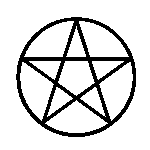Religion (re·li·gion) n
1. People’s beliefs and opinions concerning the existence, nature, and worship of a deity or deities, and divine involvement in the universe and human life
2. A particular institutionalized or personal system of beliefs and practices relating to the divine
3. A set of strongly held beliefs, values, and attitudes that somebody lives by
4. An object, practice, cause, or activity that somebody is completely devoted to or obsessed by
5. Life as a monk or a nun, especially in the Roman Catholic Church
(Encarta® World English Dictionary © 1999 Microsoft Corporation. All rights reserved. Developed for Microsoft by Bloomsbury Publishing Plc.)
This is the dictionary’s definition of religion. Today this definition applies to numerous beliefs. But, where did this all begin? The early primitive humans (cave-men, or more scientifically Paleolithic People) have the answer to all of our questions.
Early cave art can be interpreted to have religious meanings. Some say it is art for art’s sake, but other evidence suggests differently. Definition number four states that religion is a practice or a cause that one lives by. Many of these drawings depict animals. The way of life for these people was hunting animals to survive. By this definition, these drawings would be religious and not just pretty cave illustrations. These drawings thought have been rituals for good fortune, such as a plentiful hunt.
The passage in Paleolithic art and Religion (written by Jean Clottes and David Lewis-williams) about shamanism and the Ur-religion made complete sense. The concept of what is real and what is not could possibly be very blurred at this point as people where not as developed as we are today, so dreams and hallucinations could be considered gateways to the “otherworld.” I find this very fascinating, as I have had dreams of death and future things, some of which have actually come true to come, some of which have actually come true. Native Americans use the hallucination power of peyote for vision quests and rites of passage. Today, these people are just as advanced and still use the same rituals. There is something to be said for that, perhaps, hallucinations are more than just a wild a wacky time.
Why are there many drawing deep within the caves? Logically one would say that the surface on which to draw is ideal and the image will last longer etc… But, perhaps it is part of the religion. The Paleolithic people worshiped the animals, maybe the earth, which held everything together was the highest overall being. Some may call this paganism. It makes sense, for in a way the earth is the creator of all things and has power over all things upon it. In the eyes of the Paleolithic people, the earth was what we modern people call God, Allah, the Great Spirit etc… (with a capital G).

No comments:
Post a Comment